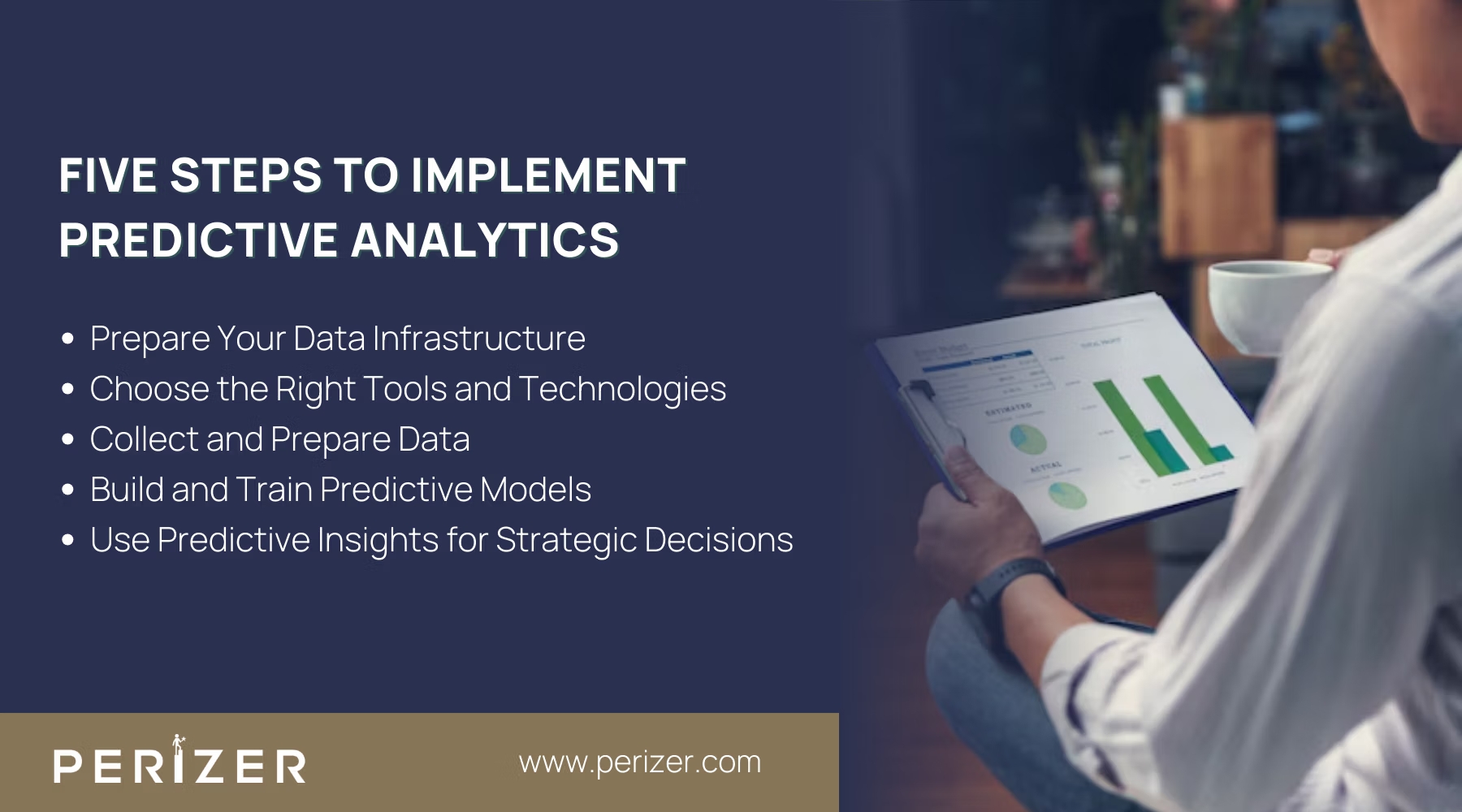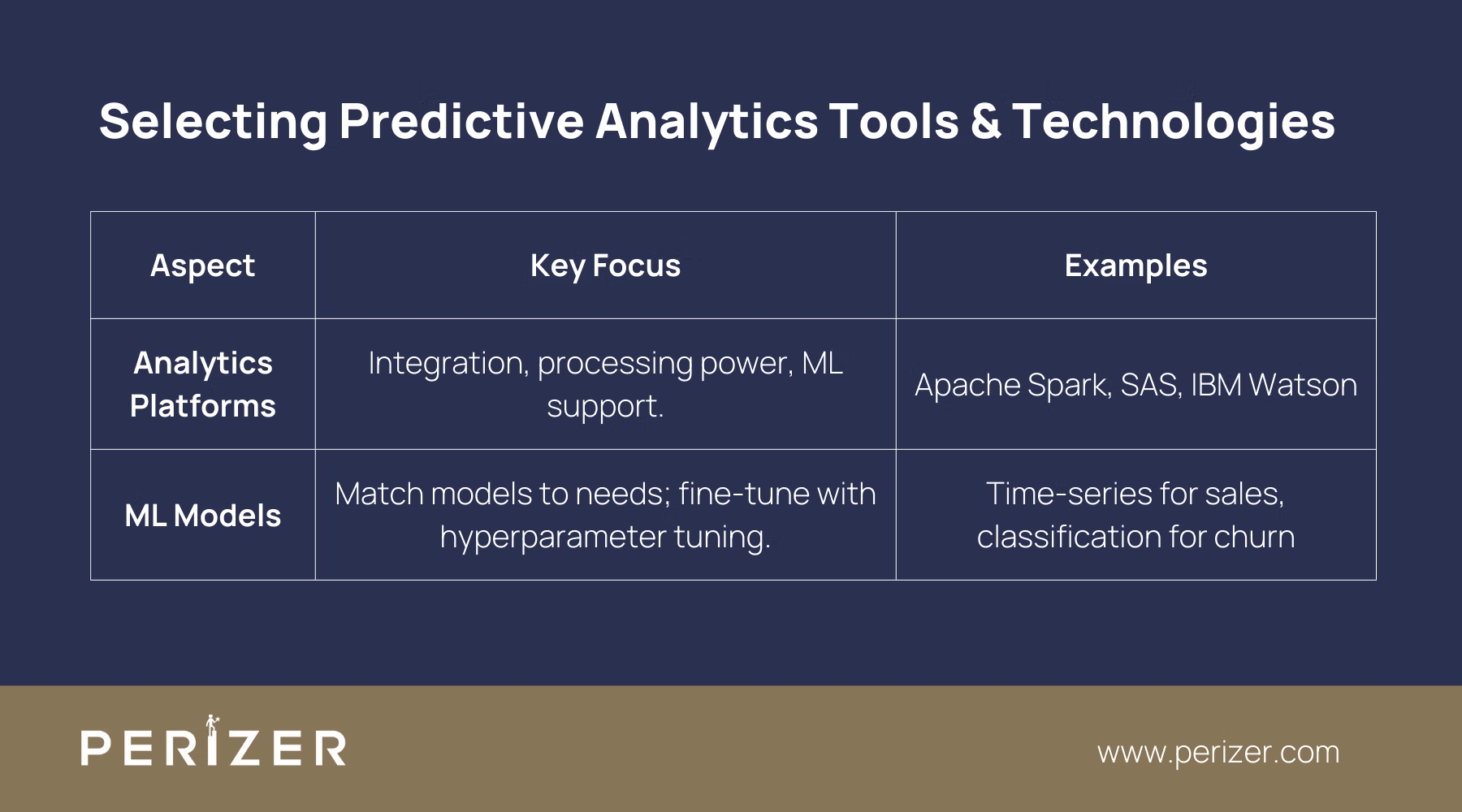5 Steps to Implement Predictive Analytics in Business
Improve your business by using predictive analytics to anticipate trends, make smarter moves, and outpace the competition with data-driven insights.

If you’re not using predictive analytics, you’re missing out on insights that could give your competitors a serious advantage. With the potential to increase revenue by 10-20%, predictive analytics is no longer a futuristic concept but a powerful tool for businesses looking to anticipate trends, understand growing customer behaviors, and predict potential problems before they arise. In a world that's always in motion, being able to see what's coming next gives you a real advantage.
Predictive analytics gives you an advantage, transforming your data into clear guidance that helps you make better decisions, streamline your operations, and stay ahead of potential risks. But to make it work for you, it’s not enough to just scratch the surface - you need a well-thought-out approach that fits your specific goals.
In this guide, we’ll cover the steps to implement predictive analytics, help you choose the right tools, and provide strategies to keep your decisions sharp and effective. Whether you’re fine-tuning your strategy or looking to get more value from your data, this guide will help you make the most of predictive analytics.
5 Steps to Implement Predictive Analytics in Business

1. Preparing Your Data Infrastructure
The success of predictive analytics depends on having a strong data foundation. Before jumping into model development or choosing algorithms, it’s important to make sure your data infrastructure is solid.
A. Assessing Data Maturity
Start by taking a close look at your current data capabilities. Go beyond just listing your data assets - conduct a thorough review of your data sources, checking for availability and quality. This means assessing not only the structured data in your databases but also unstructured data from places like social media, emails, and other less obvious sources.
To improve your data maturity, think about implementing a comprehensive data governance framework. This should include clear policies for ensuring data accuracy, consistency, and security. It’s also important to establish clear ownership of data, so everyone in your organization understands their role in managing it. By doing this, you’ll build a strong foundation for reliable and actionable predictive analytics.
B. Building a Scalable Data Architecture
Once you’ve assessed your data maturity, focus on building a scalable data architecture. This isn’t only about increasing storage capacity; it’s about designing a data pipeline that can efficiently handle the influx of large datasets required for predictive analytics.
Start by architecting a data pipeline that supports real-time data ingestion, storage, and processing. Integrate cloud and hybrid solutions to enhance scalability. A hybrid cloud model, for instance, can offer the flexibility of on-premise control with the scalability of cloud services. This setup is particularly useful when handling sensitive data that requires stringent security measures while still needing the flexibility to scale.
2. Choosing the Right Tools and Technologies
The tools and technologies you choose will significantly influence the effectiveness of your predictive analytics efforts. It’s not just about picking the most popular tools, but about selecting those that align best with your specific business needs.

A. Choosing Advanced Analytics Platforms
When evaluating predictive analytics platforms, focus on integration capabilities, data processing power, and ease of use. Consider whether the platform supports the integration of machine learning models and can handle the volume and velocity of your data.
Open-source tools like Apache Spark offer flexibility and a strong community of support, making them a good option if you have the internal expertise to customize and manage them. However, commercial solutions often come with the advantage of dedicated support and more powerful features. Tools like SAS or IBM Watson might offer pre-built solutions that can accelerate your implementation, especially when time-to-market is a critical factor.
B. Integrating Machine Learning Models
Integrating machine learning models into your predictive analytics setup takes careful planning. Start by choosing the right models that align with what you want to predict. For example, if you’re forecasting sales, a time-series model might work better than a classification model.
Once you’ve chosen your model, focus on fine-tuning it for accuracy. One key step is hyperparameter tuning, which involves adjusting your model’s settings to get the best possible predictions. Also, don’t overlook feature engineering - this is where you create new variables from your existing data, giving the model more relevant information to improve its performance.
3. Data Collection and Preparation
The accuracy of your predictive models directly correlates with the quality and relevance of the data you collect and prepare. This phase demands close attention to detail and advanced strategies.
A. Advanced Data Collection Strategies
For businesses needing up-to-the-minute predictions, real-time data collection is most significant. To achieve this, you can integrate IoT devices and other real-time data sources into your analytics pipeline. For instance, in retail, IoT sensors can track inventory levels in real-time, which, when paired with predictive models, helps you optimize stock and reduce waste.
It’s also important to make sure the data you’re collecting is diverse and relevant. A varied dataset improves your model’s ability to accurately predict future trends. Using techniques like stratified sampling ensures your data captures all the necessary variations within your target population, leading to more accurate and dependable predictions.
B. Data Cleaning and Preprocessing
Once you’ve collected your data, the next step is cleaning and preprocessing it. This stage often involves dealing with complex tasks such as handling missing data, removing outliers, and normalizing data.
For missing data, advanced techniques such as multiple imputation or the use of algorithms designed to handle missingness (like XGBoost) can be employed. When dealing with outliers, it’s important not just to remove them but to understand their origin. Sometimes, what appears to be an outlier could represent a significant anomaly worth investigating further.
Feature engineering should also be a priority at this stage. This process involves creating new variables (features) from raw data that better represent the underlying problem you’re trying to solve. For instance, creating a feature that captures the rate of change in sales over time might provide more predictive power than just using raw sales figures.
4. Building and Training Predictive Models
With a clean and well-prepared dataset, you’re ready to move on to the core of predictive analytics: model building and training.
A. Model Selection and Development
Choosing the right predictive model starts with a clear understanding of your specific business problem. First, define what you’re trying to predict - is it something that falls under classification, regression, or time series forecasting? Once you’ve nailed down the objective, you can select the model that best fits the task.
For instance, if your goal is to predict customer churn, a classification model like logistic regression or a decision tree might be the way to go. On the other hand, if you’re forecasting sales, a time series model like ARIMA would likely be more effective.
It’s also important to align algorithms to your business needs. This might mean tweaking existing models to better align with your unique data or even developing custom algorithms if the standard options aren’t cutting it. The aim is to build a model that not only fits your current data but also performs well with new, unseen data in the future.
B. Training Models with Advanced Techniques
The true impact of predictive analytics becomes clear when you start training your models. Start by dividing your data into a training set and a testing set. You’ll develop your model with the training data and then use the testing data to validate its accuracy.
To improve predictive accuracy, consider ensemble learning techniques. Methods like boosting, bagging, and stacking combine multiple models to create a single, more precise prediction. For instance, boosting train models one after the other, with each new model correcting the errors of the previous one. This can significantly enhance accuracy, especially with complex datasets.
Keep an eye on overfitting and underfitting. Overfitting occurs when your model is too complex, capturing noise rather than true patterns, which hurts its ability to generalize to new data. Underfitting happens when the model is too simple and misses important patterns in the data. Techniques like cross-validation, where you test the model on different data subsets, can help you catch and correct these issues.
5. Operationalizing Predictive Analytics
Once your models are trained and validated, the next step is to operationalize them - integrating predictive analytics into your business processes to drive real-world outcomes.
A. Model Deployment Strategies
Rolling out predictive models takes careful planning to make sure they fit smoothly into your business operations. One effective way to do this is by using APIs (Application Programming Interfaces), which let different software systems talk to each other. This setup allows for real-time predictions that can instantly influence your decision-making.
As you deploy these models, it’s important to have a plan for keeping an eye on their performance. Automated systems can monitor how well the models are working and catch any changes in the data or predictions. These systems should be set up to alert you if a model’s performance drops, so you can step in and either review or retrain the model as needed.
B. Monitoring and Maintenance of Models
Even after deployment, predictive models require ongoing attention. Implement continuous monitoring to ensure the model’s predictions remain accurate over time. This involves setting up automated systems to regularly check the model’s performance against new data and retraining the model as necessary.
Moreover, as new data becomes available, your models will need to be updated to reflect the latest trends. Implement a robust process for model retraining, including automated data ingestion, preprocessing, and model evaluation. This ensures that your predictive analytics remain relevant and accurate, providing continuous value to your business.
6. Using Predictive Insights for Strategic Decisions
The main aim of predictive analytics is to turn data insights into actions that increase your business’s success. To make this happen, it’s essential to align these insights with your specific business goals.
A. Turning Predictions into Actionable Strategies
To make sure your predictive insights match your business goals, begin by clearly defining what you want your models to achieve. For instance, if your goal is to improve customer retention, focus on models that can spot at-risk customers early on. Then, use these predictions to create targeted strategies, like personalized marketing campaigns or loyalty programs.
Another useful approach is scenario analysis. By simulating different future scenarios with your predictive models, you can plan for various possibilities and create backup plans. This approach not only strengthens your overall strategy but also helps you make better decisions when facing uncertainty.
B. Driving Change with Predictive Analytics
For predictive analytics to truly make a difference in your business, everyone in the organization needs to get on board. Start by creating a data-driven culture where employees understand and value the role of data. Offer training and resources to help them see how predictive insights can be applied in their everyday work.
It’s also important to regularly track and share the impact of your predictive analytics efforts. Focus on metrics that directly relate to business goals, like higher revenue, lower costs, or better customer satisfaction. By showing the real benefits of predictive analytics, you can build stronger support and enthusiasm for these tools across the organization.
Conclusion
Implementing predictive analytics in your business isn’t just a one-time task; it’s an ongoing journey of fine-tuning and growth. By building a solid data foundation, selecting the right tools, and continuously improving your models, you can fully use the potential of predictive analytics to drive smart decisions and stay ahead of the competition.
As you progress, it’s important to stay informed about new developments, like AI-driven automation and ethical AI, which are set to influence the future of predictive analytics. Keeping up with these trends will help you ensure that your predictive analytics capabilities remain at the forefront, consistently adding value to your business.
FOCUSED, FAST, GOVERNMENT READY
Stay Tuned With Our Latest Insights

Staff Augmentation
Learn how to select the perfect IT outsourcing partner to promote your team’s capabilities, improve productivity, and drRead more...

Staff Augmentation
Find the perfect staff augmentation partner by aligning your goals, evaluating expertise, managing costs, and ensuring aRead more...

Cyber Security
We focus on understanding the needs, behaviors, and expectations of your users through extensive user research. This infRead more...